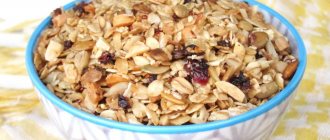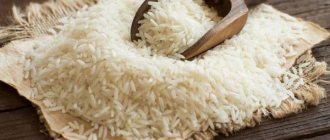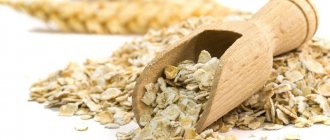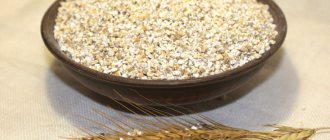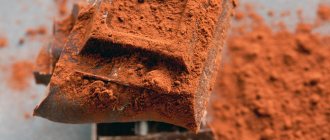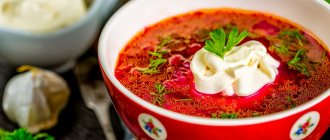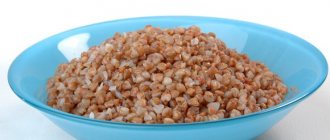Author: Kristina Lobanovskaya, doctor, practicing nutritionist Article updated: 11/09/2020
Ask a Question
When following weight loss diets, performance and reaction speed often decrease. You can eliminate unpleasant symptoms by including cereals - natural sources of carbohydrates - in your diet. Millet porridge, whose calorie content is low, seems to be an excellent option. You can prepare it in different ways, in any case enriching the body with vitamins and getting a lasting feeling of satiety.
Glycemic index
The glycemic index is a coefficient that indicates the ratio of a food product to the glucose level in a person’s blood. The higher it is, the faster carbohydrates are absorbed, increasing blood sugar levels.
For people diagnosed with diabetes, the food index should be within 40.
Millet porridge has a fairly high GI - from 40 to 60. The thicker it is cooked, the higher this indicator.
Millet porridge
Extra pounds and the fight against them have become especially important. Porridges are an integral part of almost every diet. The healthiest cereals are in the public domain; you can use them to make salty or sweet porridge. Millet is considered the most popular and budget grain. Millet porridge is prepared in the shortest possible time and is most often eaten for breakfast. It is mainly prepared by combining with:
- Vegetables;
- Dried fruits;
- Mushrooms;
- Meat.
Beneficial features
Ready-made porridge contains a large amount of useful substances that are necessary for the human body.
Product benefits:
- Cleanses the blood of toxins.
- Has a positive effect on the gastrointestinal tract after taking antibiotics.
- Helps with weight loss (only if the porridge is cooked in water).
- Fights diseases of the heart and blood vessels.
- Helps strengthen the muscular system due to the presence of amino acids.
The beneficial properties of millet for different categories of people are reflected in the table:
| Category | Properties |
| Children | The dish contains many useful substances that are necessary for a growing body:
Children under one and a half years old should be given crushed millet. Before cooking, the cereal must be thoroughly rinsed, which will help eliminate bitterness. |
| Pregnant | Millet will help normalize the gastrointestinal tract and prevent you from gaining excess weight. Contains all the necessary vitamins and minerals for fetal development. Cereals must be consumed with other cereals: buckwheat, semolina, rice, oatmeal |
| Women | Millet prevents the appearance of facial wrinkles and fights age-related ptosis (drooping). Maintains oval and even complexion, stimulates hair growth, strengthens nail plates, removes waste and toxins from the female body |
| Men | Helps restore lost energy and cleanses blood vessels. Helps in the functioning of the gastrointestinal tract, serves as the prevention of heart attacks and strokes. Provides the body with the necessary amount of calories |
Composition of cereals
Millet contains:
- Potassium and magnesium, which help strengthen blood vessels and improve the functioning of the cardiovascular system.
- Copper is an element that smoothes wrinkles and improves skin condition.
- Silicon – strengthens teeth, hair and joints.
- Iron is an element that improves the blood formula and is involved in the production of red blood cells.
- Iodine is a trace element necessary for the functioning of the thyroid gland.
- B1 – strengthens the immune system, helps overcome depression.
- PP is a vitamin that protects the skin and mucous membranes.
Harm and contraindications
Despite the presence of a large number of useful substances, millet porridge has several contraindications and can be harmful in the following cases:
- Problems with the thyroid gland.
- Kidney diseases.
- Urolithiasis.
- Calcinosis.
- Gout.
- Stomach diseases (high acidity).
- Increased gas formation.
- Individual intolerance.
Men should not consume millet too often: this can negatively affect potency. The product should be combined with dried fruits, vegetables, nuts or herbs.
If a pregnant woman has increased stomach acidity, consuming millet will negatively affect the functioning of the organ. If you eat porridge with butter and sugar, you can gain excess weight.
Excessive consumption of millet slows down the process of iodine absorption.
Contraindications for children:
- digestive system problems, stomach upset;
- chronic constipation, gastritis (low acidity);
- pathology of the thyroid gland.
The product is not allergenic, but you need to make sure that the child does not have individual intolerance. For children prone to allergic reactions, millet should be administered with caution.
The nutritional value
Today, millet cereals are not as popular as they used to be. But if you remember the chemical composition of the product, it becomes rational to introduce it into the diet. The finished dish contains essential amino acids, which act as building materials for muscles and skin cells, healthy vegetable fats and complex carbohydrates, which help cleanse toxins and waste. The porridge is definitely healthy due to the content of plant fiber, which “sweeps out” everything harmful. Millet is also a source of starch. By consuming a serving of millet every day, you can protect your body from various diseases and normalize your overall well-being.
Proteins fats carbohydrates
Macronutrients are irreplaceable components of food, and millet cereals are ready to supply them to the human body, regardless of the method of preparation. Cereals are classified as carbohydrate foods. Thus, with a calorie content of 342 kcal per 100 g, dry raw materials contain 66.5 g of carbohydrates. The ratio of proteins and fats is 11.5 and 3.3 g, respectively.
After boiling in water, the calorie content of millet cereal is reduced to 90 kcal per 100 g, and the BJU ratio becomes as follows:
- proteins – 3.5 g;
- fats – 0.4 g;
- carbohydrates – 21.4 g.
If you add sugar to the dish, the calorie content will be 73 kcal. The carbohydrate level will be 16.2 g, protein and fat - 2.5 and 0.6 g, respectively. When adding butter to an already sweetened product, the calorie content will increase to 154, and the BJU ratio will acquire the following indicators:
- proteins – 3.7 g;
- fats – 5.7 g;
- carbohydrates – 23.3 g.
You can also boil cereals without using sugar, adding only butter. Then it will contain the following content:
- proteins – 4.1 g;
- fat – 4.6 g;
- carbohydrates – 25.1 g.
100 g of crumbly millet porridge contains a calorie content of 130 kcal. The BZHU indicators are as follows:
- proteins – 4.7 g;
- fats – 1.1 g;
- carbohydrates – 26.1 g.
Millet grains cooked in milk, with an average calorie content of 110 kcal, contain 3.8 g of protein, 5.3 g of fat and 10.3 g of carbohydrates. When sugar is added, the energy value increases to 135 kcal, and the BJU indicators become as follows:
- proteins – 3.9 g;
- fats – 5.3 g;
- carbohydrates – 21.1 g.
If you replace sugar with butter, the results will be like this:
- proteins – 4.1 g;
- fats – 4.6 g;
- carbohydrates – 25.1 g.
Milk millet porridge can be prepared using both ingredients, achieving the following BJU indicators with a calorie content of 147 kcal per 100 g:
- proteins – 4.3 g;
- fats – 2.5 g;
- carbohydrates – 21 g.
By adding pumpkin to lean millet cereal, it is possible to change not only the calorie content, but also the composition of the BJU to the following values:
- proteins – 2.7 g;
- fats – 2.2 g;
- carbohydrates – 16.4 g.
Using pumpkin in a millet milk dish gives the following results:
- proteins – 2.8 g;
- fats – 2.4 g;
- carbohydrates – 15 g.
Macro- and microelements
Finished millet cereal, as well as the raw materials for its preparation, is rich in minerals, including both micro- and macroelements:
- Titanium – participates in the formation of red blood cells in the bone marrow, helps in the synthesis of hemoglobin and maintaining immunity.
- Tin – promotes the activation of enzymes responsible for digestive processes and cell growth.
- Nickel – stimulates hematopoietic processes, is involved in fat metabolism and is associated with glucose metabolism.
- Aluminum – is associated with regeneration and restoration processes, activates the activity of the digestive glands.
- Cobalt – promotes bone growth, stimulates hemoglobin synthesis and is involved in the production of thyroid hormones.
- Molybdenum – helps in the absorption of vitamin C and the synthesis of amino acids in the human body.
- Fluoride – required for the formation and protection of hard dental tissue and enamel, strengthens bones.
- Chromium – strengthens bone tissue, prevents osteoporosis and maintains normal blood pressure.
- Manganese – normalizes the functioning of the nervous system, synthesizes the hormone thyroxine and fatty acids.
- Copper is involved in the breakdown of carbohydrates and fats, is necessary for the synthesis of phospholipids and promotes the production of hemoglobin.
- Iodine – participates in the regulation of energy metabolism, regulates water-electrolyte metabolism, supports the functioning of the central nervous system.
- Zinc is involved in the breakdown of fats and carbohydrates, is necessary for the normal metabolic process in the thyroid gland and helps maintain the integrity of teeth.
- Iron is necessary for many proteins and enzymes to control cholesterol metabolism, the process of hematopoiesis and energy metabolism.
- Sulfur protects cells and tissues from oxidation, and the body from the toxic effects of foreign elements.
- Chlorine is one of the main elements of water-salt metabolism, improves the functioning of the digestive tract and liver.
- Phosphorus – improves metabolism, normalizes energy metabolism and coordinates acid-base balance.
- Potassium – activates protein and carbohydrate metabolism, is necessary for converting glucose into glycogen, improves intestinal function.
- Magnesium – has a beneficial effect on bone growth, strengthens tooth enamel, and regulates blood sugar levels.
- Sodium – transports amino acids across cell membranes, affects protein metabolism, activates pancreatic enzymes.
- Calcium - serves as a structural material, maintaining healthy bones and teeth, and also coordinates the heartbeat and supports the central nervous system.
Due to the fact that there is synergy between minerals, a diet using millet is easily tolerated, and the body does not suffer from a lack of nutrients.
Vitamins
The vitamin composition of “golden” cereal is not as extensive as the mineral one, but it contains all the components necessary for the health of the body and improvement of the figure. Thus, the presence of B vitamins is noted in the finished grains:
- B9 or folate - takes part in protein metabolism, regulates the activity of the nervous system, improves sleep and appetite.
- B6 or pyridoxine - is involved in almost all metabolic processes, supports the immune system and ensures the normal functioning of the central nervous system.
- B3 or nicotinic acid - helps the absorption of fats and proteins, supports the functioning of the brain and cardiovascular system.
- B2 or riboflavin - is involved in the synthesis of nerve cells, regulates the functioning of the adrenal glands and is necessary for better absorption of iron.
- B1 or thiamine - takes part in many metabolic processes, ensures the normal functioning of the nervous system and keeps the heart muscles in good shape.
Along with the most important B vitamins, cereals and finished dishes made from them contain the following useful substances:
- Vitamin A (beta-carotene) – stimulates immune function, supports adrenal function and maintains visual health.
- Vitamin E (tocopherol) – is endowed with antioxidant properties, ensures carbohydrate metabolism and improves tissue respiration.
By consuming at least a portion of millet porridge per day, you will be able to enrich your body with all the vitamins listed and prevent deterioration in your health due to limited nutrition.
The introduction of millet cereals into the diet has more advantages (low calorie content and quick satiation are among the first) than disadvantages. But the benefits and harms should be considered equally carefully, because there are still some pitfalls. Thus, it is undesirable to abuse the dish if you are prone to constipation, reduced stomach acidity, or thyroid dysfunction. Excessively long and regular consumption of millet porridge can affect the functioning of some organs and systems of the body.
Use for weight loss
The dietary product has a positive effect on the human body and promotes weight loss:
- Cleanses the body of waste and toxins.
- Removes excess liquid.
- It satisfies quickly and for a long time, thanks to which a person does not feel hungry.
- Improves carbohydrate metabolism.
- Prevents fat accumulation.
To lose weight, millet must be consumed without oil, sugar and other additives, otherwise the number of calories in such a dish will double.
If you eat millet correctly, you can get rid of 4 to 10 kg of excess weight in one week. Those who are losing weight should carefully plan their diet and introduce additional foods into it:
- kefir;
- fruits and vegetables;
- greenery;
- boiled fish and tender meat;
- seafood;
- berries.
There are several diets that help you lose weight and lose up to 10 kilograms in 7 days.
Diet 1
Ingredients:
- millet – 150–200 g;
- water – 450–600 ml;
- sesame - to taste;
- vegetable oil – 1–2 tsp.
Preparation:
- Millet must be thoroughly washed.
- Pour the cereal into the water and place on low heat. Cook until done.
- Add sesame seeds and oil to taste.
Cooked millet must be divided into equal portions and consumed throughout the day.
The diet must be followed for seven days. It is allowed to drink tea and water. Some nutritionists allow drinking coffee without added sugar.
Diet 2
Millet must be prepared as in the first diet, but additional products can be introduced into the diet:
| Breakfast | Dinner | Afternoon snack | Dinner |
|
| Choice of: a glass of milk, yogurt or kefir | 200–300 g of fruit (grapes and bananas are prohibited) |
When choosing a diet, it is recommended to consult a nutritionist to avoid negative consequences and health problems.
Calorie content of millet porridge
- Take the total amount of millet;
- Enter its quantity into the phone application or online - counting;
- Add to the list the number of added components;
- Add up - we get the total calorie content; divide into portions, we get the amount that was consumed at a particular time.
If you are not able or willing to do your own calculations, you can refer to the table with approximate calculations:
It is possible to reduce the calorie content by adding a light addition to the porridge - pumpkin, lettuce, etc. The dish will become more satisfying with milk or butter.
Is millet porridge good for weight loss?
Nutritionists approach weight loss simply: you can eat any product to which you are not allergic, the main task is to meet the daily intake of proteins, fats, and carbohydrates. Millet porridge is one of the suppliers of carbohydrates and the simplest sources of mental work, muscles and metabolic processes. Without receiving carbohydrates, a person will not be able to lose weight because:
- Ignoring them slows down your metabolism;
- Over time, their lack causes increased appetite, and overeating begins.
If you don’t need to achieve an ideal figure in a couple of days, then to properly lose weight you just need to create a calorie deficit. It’s not easy for everyone to get used to millet porridge, and not everyone likes it. If you particularly dislike it, you can add butter or pumpkin for a sweet effect.
A serving of 300 grams will have an insignificant effect on the body even with the addition of additional products.
Benefits of millet for weight loss:
- Quick feeling of fullness;
- Many have become accustomed to it since childhood;
- Saturates with vitamins;
- Serves as prevention against pathologies;
Disadvantage of millet porridge: most people have a hard time getting used to millet on water.
Scientists have confirmed that carbohydrates cannot be formed into fat deposits, and if adding millet to the diet does not have a weight loss effect, you should recalculate calories or start weighing foods.
Recipes
Millet porridge can be prepared with water or milk with the addition of sugar and pumpkin.
Millet porridge with milk and sugar
Ingredients:
- millet cereal – 250 g;
- milk – 150 ml;
- butter – 25 g;
- sugar – 1 tbsp. l.;
- salt - to taste.
Preparation:
- Boil milk and add millet to it.
- Cook for 20-25 minutes over low heat, stirring constantly.
- Add sugar and salt to taste to the finished porridge, leave for 15 minutes.
- Add butter.
The calorie content of the finished dish is 245 kcal per 100 g of product. BJU: 6/7/39
Millet with milk and pumpkin
Ingredients:
- millet cereal – 300 g;
- milk – 200 ml;
- sugar – 1 tbsp. l.;
- pumpkin - 80 g;
- salt - to taste.
Preparation:
- Pour millet into milk with pumpkin and cook over low heat until tender.
- Add sugar and salt to taste to the finished milk porridge and leave for 20 minutes.
If you cook millet without adding sugar, the calorie content of the dish will be significantly reduced and will be only 105 kcal. BJU: 4/5.8/10.7 g.
Dry
Millet is used to prepare millet porridge. It is made from millet, rich in microelements and vitamins. Dishes made from it turn out tender and tasty, and most importantly, they are quite easy to digest. It is noteworthy that this is one of the few cereals in which a record high amount of plant protein is determined, which is necessary to maintain strength and health in any diet.
For the first time, cereals, which are often called “golden”, were grown in China and Mongolia. Today it is widespread in many countries of the world and is successfully used in the cuisines of different nations. The grains of the cereal have a round shape and a specific smell, and are colored yellow. Also on store shelves you can find crushed cereals, which are cleaned in a special way and have a slightly flattened shape.
The calorie content of the dry product is quite high - 342 kcal per 100 grams, and the glycemic index is at an average level - 40 units. When cooked, the volume of millet increases and the calorie content decreases, so nutritionists recommend including the finished product in a limited diet. As for the health benefits of raw materials, it has been known for a long time. It seems especially valuable for people with heart pathologies. Since potassium is determined in the composition, in addition to benefits for the heart muscle, we can talk about normalizing blood pressure and removing excess fluid from the body. Millet cereal has an equally beneficial effect on the process of hematopoiesis and liver function. Experts note that it must be present on the table of people with diabetes, atherosclerosis and problematic pancreas.
To experience the effectiveness of millet in terms of health improvement and weight loss, you need to choose a quality product:
- The yellower the color of the grains, the tastier they are, so you need to choose a product in transparent packaging.
- The cereal should be matte. The presence of shine indicates the absence of polishing.
- The shelf life of the product cannot be long.
- The cereal should not have any foreign odor.
Important! A short shelf life - no more than 9 months - is one of the features of millet. This is due to the presence of fats in it, which undergo oxidation during storage. The longer millet cereal is stored, the more bitter its taste becomes.
First of all, millet cereals are used for preparing porridge, but are used with equal frequency in recipes for various baked goods, meat dishes and side dishes.
The benefits of millet
- Consumption of millet porridge in moderate quantities will saturate the body with a number of vitamins, for example, magnesium, zinc, iron, copper or potassium.
- Millet does not contain proteins that are hard on the body, which allows it to be eaten by children or adults in their diet.
- Millet contains beneficial fiber, which makes it recommended for patients with gastritis.
- It is also recommended when taking antibiotics, as it can cleanse the body and reduce the harm from the medications consumed.
- The food is well digestible, common, and inexpensive.
Millet porridge cannot cause any significant harm unless a person consumes too much of it and does not diversify his diet. The product will also be harmful for patients with dyskinesia and those who consume millet without butter or milk. The same rule applies to all patients with the gastrointestinal tract; porridge for them should be replaced with another dietary product, something puree-like and easily digestible.
Millet porridge is the very dish that is strongly associated with traditional Russian cuisine. Or with another kitchen – grandma’s. Even those children who are usually difficult to feed porridge will not refuse “millet”. For adults, it can become not only a healthy and nutritious breakfast, but also an integral part of the diet. In addition to calorie content, you can read a separate issue about.
The benefits of millet
The benefits of millet are determined by the high content of nutritional components needed by the body in these grains. Food products prepared with millet are recommended to be consumed in the presence of pathologies of the gastrointestinal tract, as well as in case of narrowing of the esophagus of any etiology.
The high concentration of polyunsaturated fatty acids and potassium in millet determines its use during a therapeutic course for cardiovascular pathologies, in particular when diagnosing atherosclerosis. Used to prevent osteoporosis and iron deficiency anemia.
This is the only food product that does not oxidize when exposed to high temperatures. Therefore, it can be safely consumed if you have an allergic reaction to gluten.

